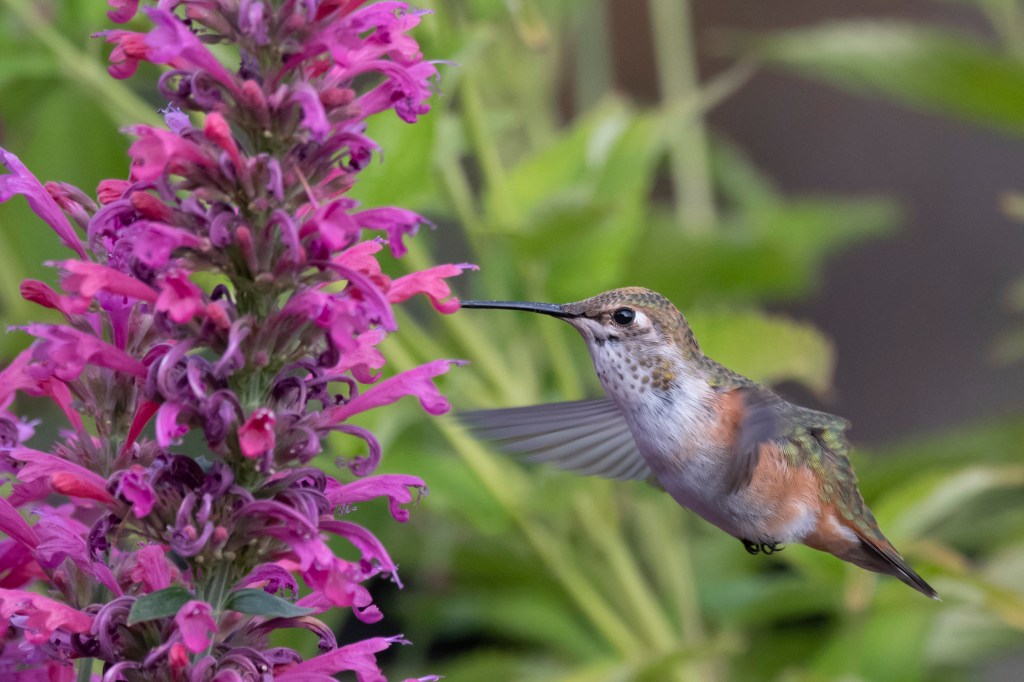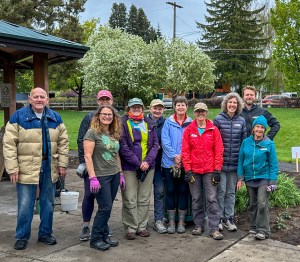A first-of-its-kind native hummingbird garden takes root in Bend
Published 9:30 am Thursday, June 5, 2025

- A rufous hummingbird, Central Oregon’s most common hummingbird species. (Courtesy Barb Rumer)
Gwen Bartonek is endlessly fascinated by hummingbirds. She loves observing their territorial behavior.
“They wait and they look at their territory all day and as soon as somebody else comes, they dive bomb each other and they fly in the air. It honestly looks like World War II. It’s so funny to watch,” she said.

A sign marks the under-construction hummingbird garden at Orchard Park in Bend. (Courtesy Gwen Bartonek)
Bartonek, president of Pollinator Pathway Bend, is looking forward to enjoying her morning coffee while observing “hummingbird wars” in Bend’s Orchard Park, where she has designed Central Oregon’s first native hummingbird demonstration garden.
Trending
In a couple of years, it’s likely to become home to rufous hummingbirds (the most common hummingbird species in Central Oregon), with some sightings of Anna’s hummingbird or the rare Calliope hummingbird, the smallest known birds in North America.
The tiny birds will be attracted to the garden’s native plants, which include agastache (also known as hummingbird mint), scarlet gilia, penstemon, columbine, flowering currant, serviceberry and milkweed.
Hummingbird haven

Volunteers plant native plants in Orchard Park for a hummingbird demonstration garden. (Courtesy Gwen Bartonek)
Volunteers with the Pollinator Pathway, East Cascade Birds Alliance and Wild Birds Unlimited, collaborated to install a garden that suits the various needs of hummingbirds. Building for the garden began in May and was funded by a grant from Bend Park & Recreation District.
The project idea came from Barb Rumer, former president of Pollinator Pathway, according to a press release. Rumer was inspired by Doug Tallamy, an entomologist and author, who preaches a 70-30 rule, which involves planting no more than 30% non-native species.
Bartonek’s design of the native garden has a higher ratio of non-native to native plants than Tallamy recommends. It includes almost entirely native species, crafted to cater to hummingbirds, with flowers in a tubular shape and ripe with nectar, plants that attract insects the birds like to eat and places to perch or reproduce.
“This garden is more than a beautiful space — it’s a living example of how even small residential gardens can support wildlife when we choose native plants,” Bartonek said.
Trending
The native garden also has lower water usage and is more fire-resistant relative to non-native plants.
It’s all part of the nonprofit’s efforts to demonstrate the benefits of choosing native plants for home gardens, Bartonek said.
Growing the pollinator pathway
A chart featuring Central Oregon native pollinator plants, with bloom time, types of pollinators the plants attract and more, is accessible on Pollinator Pathway’s website, along with other resources on creating a pollinator-friendly habitat.
Bartonek and the nonprofit group, all of whom are volunteers, are working to grow the pollinator pathway, one small chunk of land at a time, by weeding invasive species and planting native plants to attract more pollinators. Bartonek hopes to watch the number of pollinator species tick up, while water usage plummets, data points monitored by the city.
The effort began with Basey Klopp and a small group of volunteers in 2020, who worked with local businesses, the city and Bend Parks to plant over 1,000 plants, laying the groundwork for the nonprofit organization.
Last year, the group planted a moth garden at Sunriver Nature Center & Observatory.

Volunteers pose for a photo at Bend’s Orchard Park after helping plant a native hummingbird garden. (Courtesy Gwen Bartonek)
“Moths are way better pollinators in almost every aspect than bees, but because they’re nocturnal, nobody thinks about them,” Bartonek said.
Residents are invited to join the pathway by planting native pollinator-friendly plants,
reducing lawn size and avoiding the use of pesticides and lawn chemicals.
In the next 10 years, Bartonek hopes to watch the pathway expand, connecting south to Sunriver and north to Redmond.
She also hopes more people will join her “ragtag group of bee and pollinator-loving volunteers.”
How can I get involved?
Many opportunities are on the horizon to connect with the organization, learn about native plants or grow the pollinator pathway.
Every Thursday at 10 a.m. through September, the group meets for a “garden party” at Franklin’s Corner Community Garden at the roundabout that connects Franklin Avenue with 9th Street to tend to the pollinator garden.
On Saturday, the nonprofit will have a table at the Central Oregon Master Gardener Association’s June Garden Fair at the Deschutes County Fair & Expo Center, where there will be a plant sale, vendors selling plants, yard art and other garden-related merchandise, as well as an opportunity to tour Oregon State University’s demonstration garden and plant clinic.
On June 14, the 5th annual WaterWise Landscape Field Day, sponsored by the city’s water conservation program and the Central Oregon Master Gardeners, will be held, offering a chance to learn more about creating beautiful, sustainable landscaping.
On June 22, the Sunriver Wildflower Show and Pollinator Festival at Sunriver Nature Center will celebrate Oregon’s wildflowers with a wildflower display, guided walks through the botanical garden and surrounding trails, education talks and native plants for sale.









